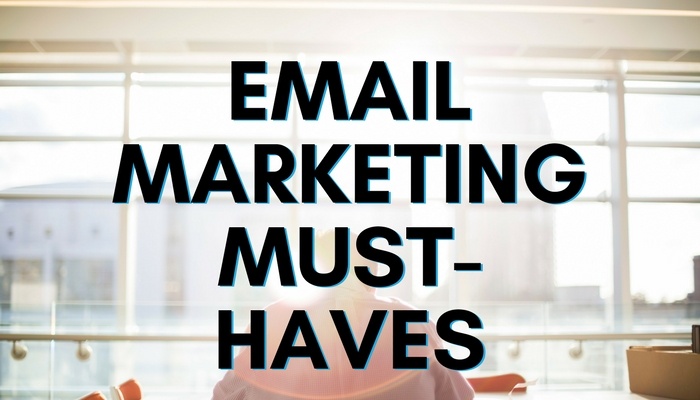- Aug 18, 2017
- By Emily Inman
- In Social Media and Digital Marketing
Get Better Results from Your Email Marketing with the Right Automation Tools

Automation is chaning the way we market — no getting around that.
When it comes to email marketing, companies that employ automation in their digital engagement and sales campaigns are seeing higher open rates, higher conversion rates, and positive ROI. Why? When you have to think about the content you're sending — offers, links, and the copy of your email itself — you're much more likely to end up crafting a message that's relevant to consumers.
Let’s take a look at some of the factors that encourage your customers to click “open.”
Figuring out the right delivery recipe for each customer.
Perceived relevance is always going to be a primary factor driving your company’s open rates. If customers cannot immediately recognize, from an email’s subject line, how and why the content inside might add value to their lives, they’ll trash it immediately and move on.
To convey relevance, subject lines should be carefully crafted. They need to speak to a consumer’s needs, using language to which she or he is demonstrably responsive.
A marketing team couldn’t possibly shape and re-shape subject lines, content, and calls to action for each customer. And 2 or 3 versions of each email won’t cut it — your company would still be painting with too-broad strokes. Your company needs the ability to auto-customize emails. Each message needs to contain a little of this, a little of that, and deliver at the right time for each customer.
And the right email marketing platform will allow you to A/B test and refine each individual piece of your email content—from subject line to signature. Add to that, the fact that automation allows companies to take advantage of timing effects that they couldn’t otherwise realize by sending emails only during their normal work hours.
Several studies have emerged that suggest there are peak efficacy times for email delivery; many of these recommend sending emails to clients at the beginning or end of their workdays — when people are likely to be checking their inboxes.
It’s not necessarily as simple as planning all your emails to drop between 9 and 10 am or 4 and 5 pm.
What about people — health care administrators, hospitality managers, and restaurateurs, for example, who don’t necessarily work 9 to 5, Monday through Friday? What about customers who are college students? Retirees? Freelancers?
The trick, of course, is to test delivery times, log successes, and correlate them then develop peak delivery profiles for each of the consumer segments you find yourself serving.
So what tools and capabilities do businesses need to successfully automate their email marketing?
Let’s talk about that. To increase engagement with your digital marketing, you need an email automation platform that offers:
Advanced List Segmentation
As you know, people don’t fit into easily defined columns; customers form a complete, smooth spectrum.
Hopefully, your CRM allows you to log and correlate consumer actions to stimuli. And, hopefully, you’re doing so—with the aim of building out profiles that your marketing team can use to shape your company’s messaging.
You’ll need the capability to organize the consumer data your business collects and generate those psychographically accurate segment profiles.
What emails does Customer A open? When does she open them? Are there patterns in Customer B’s email usage? Keywords he responds to? Are there types of subject lines — burning questions, urgent commands, etc. — that are particularly effective with segments of your audience?
And that’s just the subject lines. How are you segmenting your interior content? How are you shaping your calls to action? Can your email management system look at an individual consumer’s preferences, match them up to proven stimuli and deliver matching content?
Can it help you generate a subject line with keywords [A] and [D], composed according to tone [C], containing infographic [E] and call-to-action [B], then deliver it at time [T+2]? You need a system that can make creating emails with that level of sophistication for each customer on your list almost painless.
Those systems exist. If you want to increase your digital marketing ROI, it’s worth the spend either to invest in them and train your staff to use them properly or to outsource your digital marketing to a team that already has those capabilities in place.
Drip Campaigns
Automated drip campaigns deliver content to prospective customers. Delivery times can be based on pre-defined intervals, on actions prospects have taken on your web portal, or on myriad other factors.
Automating drip campaigns means your team isn’t spending all their time on deployments, freeing them to focus on developing compelling, effective content. And they allow your sales team to focus on lead qualification, relationship-building, and closing.
Workflow Creation
Workflows are slightly different from drip campaigns in that drip campaigns don’t necessarily call for complexity. After initial contact is achieved, drip campaigns do just as their Mr. Coffee-inspired moniker implies: they send one email after another at regular intervals. Drip, drip, drip.
Truly workflow-based digital campaigns, on the other hand, rely on branching “if this, then this” logic. They can be quite sophisticated, if not downright intricate, in design.
To achieve the best possible ROI, businesses should make sure that marketing automation platforms they employ will support the wider scope and scale of workflow-based campaigns.
They need to be able to store a lot of content on the back end, account for multiple triggering parameters, and generate robust reporting that marketing teams can use to modify and improve their messaging. They should also give you real-time ability to monitor results.
HubSpot, for example, features a user-friendly dashboard that integrates and displays analytics, so you can expand, extend, or pull the plug on a campaign once the early returns are in.
That’s extraordinarily valuable, because it allows companies to tailor their spends mid-stream, based on projected performance. Welcome to digitally-enabled margin marketing.
Is your marketing strategy ready for email automation?
If you’re not, we can help. We have deep experience with helping our clients construct, nurture and realize positive results from their automated email and integrated inbound campaigns.
Let’s talk about your company’s needs, goals, and consumer audiences.





